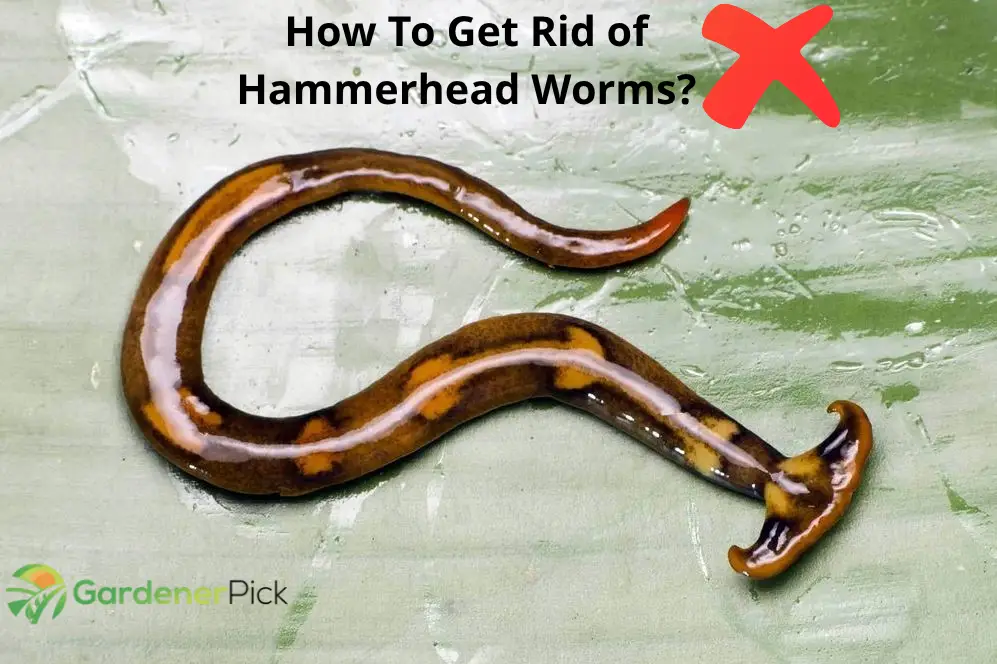There are a lot of different types of worms on this planet. Some of them are beneficial to humans such as earthworms. They can be a great asset to gardens, plants, and trees and can help them in various ways.
Also, they can be useful in protecting plants from destructive pests such as termite larvae, grubs, and other harmful pests. By burrowing into the ground, they can help in mixing the earth’s soil. However, there are some worms that can be quite dangerous such as hammerhead worms.
How to get rid of hammerhead worms? The first method to get rid of hammerhead worms is to spray citrus oil on their bodies. The second technique is sprinkling salt on hammerheads can also help. But before you try to get rid of these harmful creatures, it is important to understand their nature and the know-how they destroy in your field.
Hammerhead worms are quite destructive and therefore, need to be eliminated from the fields. They are usually seen in gardens or on plant parts. They have hammer-like heads, therefore known as hammerhead worms.
What Actually Hammerhead Worms Are
People often see worms in their gardens and fields but they don’t know whether these are hammerheads or not. Hammerheads are flatworms and their head just looks like a hammerhead shark. They are also known as shovelheads or arrowheads. These worms are usually massive and can grow to be quite large, up to 20 inches long. However, most of these grow to only an inch.
As they are nocturnal, so it is easy to find them at night, but they can be seen in the early morning as well. Hammerhead is mostly found on the top of the soil such as in a garden or one’s lawn, especially after a hard rain. Like other worms, they need a moist environment to survive and live in the soil. Just like slugs and snails, they thrive in warm and humid climes and leave a slime trail behind them. They can also be seen on tree branches and trunks and will stick to any wet surface.
As the hammerhead moves, they secrete thick and dense mucus from its undersides. Some of them have stripes while others don’t. They look a lot like slugs as they move in a slug-like fashion and their creeping soles help them during locomotion.
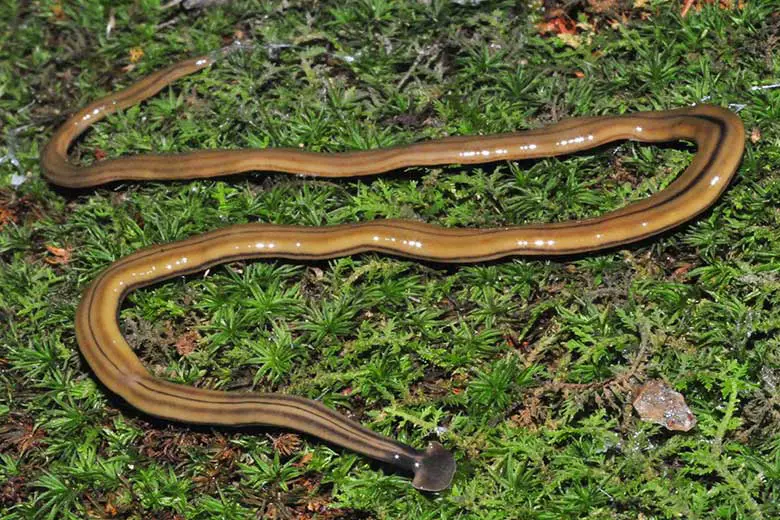
Hammerhead worms have a lot of species but their most distinctive features are their spade-shaped head and flattened body. Different species have different sizes, shapes, colors, and stripe patterns. Most of the hammerheads are earth-colored and found in shades of brown, grey, green, and gold.
Distribution and Habitat
Hammerhead worms are native to tropical and subtropical regions but at the same time, they have become invasive worldwide. It is believed that these worms were accidentally transported and distributed on rooted agricultural plants. They are not usually found in deserts and mountain biomes because they require humidity to survive.
The Downsides of Hammerhead Worms
Hammerhead worms are usually not harmful to humans, nor are they harmful to household pets. However, they are extremely harmful and damaging to earthworms. Earthworms might be small, but they are one of the most important creatures on Earth! They play an important part in soil fertilization because they excrete powerful fertilizers such as castings, also known as excrement.
Hammerhead worms follow an earthworm’s trail and then capture it. Then it holds its victim in its powerful muscles and secretes a sticky substance. Hammerhead worms eat the earthworm in a frightful manner. It pulls the pharynx out of the mouth of the earthworm and then secretes enzymes on its body. The enzymes dissolve the earthworm’s body and after this, the liquefied tissue is sucked by the hammerhead worm.
The digestion process of the hammerhead worm mostly occurs outside of its body, as the earthworm is dissolved before being consumed.
Hammerhead worms cause depletion of the earthworm population and this can be quite harmful to your garden or a field. They are an invasive species and can be quite problematic. Most of them contain potent toxins such as tetrodotoxin and neurotoxin. This helps immobilizes prey and deter predators.
Beneficial Nematodes and Fungi to Control Hammerhead Worms
Gardening can be a rewarding and beautiful experience, but it can also come with its share of pests. Hammerhead worms are one such pest that can ravage your garden. Fortunately, there are beneficial nematodes and fungi that can help control them.
Here in this table, we’ll take a look at the various types of beneficial nematodes and fungi available to help manage hammerhead worm infestations in your garden. With this information, you will be able to make an informed decision on the best approach for managing hammerhead worms in your garden.
| Beneficial organism | Description | Effectiveness |
|---|---|---|
| Steinernema carpocapsae | A nematode that infects and kills hammerhead worms by releasing bacteria into their bodies. | Highly effective |
| Heterorhabditis bacteriophora | A nematode that infects and kills hammerhead worms by releasing bacteria into their bodies. | Highly effective |
| Metarhizium anisopliae | A fungus that infects and kills hammerhead worms by penetrating their cuticles and releasing enzymes. | Moderately effective |
| Beauveria bassiana | A fungus that infects and kills hammerhead worms by penetrating their cuticles and releasing enzymes. | Moderately effective |
Note: Effectiveness may vary depending on environmental factors and application methods. Always follow product instructions carefully.
Table of Different Methods For Removing Hammerhead Worms
If you’re a gardener, chances are you’ve encountered the dreaded hammerhead worm. These pesky pests can wreak havoc on your garden, destroying plants and ruining your hard work. Fortunately, there are many effective methods for getting rid of hammerhead worms and restoring your garden to its former glory.
Here in this table, we’ll explore the various techniques available for eliminating hammerhead worms from your garden. We’ll discuss biological controls, chemical treatments, and other techniques that can be used to get rid of these troublesome pests. Check out the table for more information about the best ways to remove hammerhead worms from your garden.
| Method | Description | Pros | Cons |
|---|---|---|---|
| Handpicking | Physically removing hammerhead worms by hand. | Inexpensive, no harm to other organisms. | Time-consuming, not practical for large areas. |
| Biological control | Using beneficial nematodes or fungi to infect and kill hammerhead worms. | Effective, environmentally friendly. | May take time to see results, may require multiple applications. |
| Soil management | Long-term solution reduces likelihood of re-infestation. | Long-term solution, reduces likelihood of re-infestation. | Can harm beneficial organisms, may have a negative environmental impact, may require multiple applications. |
| Chemical control | Using pesticides or other chemicals to kill hammerhead worms. | Quick results. | Can harm beneficial organisms, may have a negative environmental impact, and may require multiple applications. |
Note: Always follow product instructions carefully and consider the potential impact on the environment before using chemical control methods.
Preventative Measures to Avoid Hammerhead Worm Infestations
If you’re a gardener, then you know that pests can be a huge hassle. But one pest you don’t want to let into your garden is the hammerhead worm. Hammerhead worms can wreak havoc on a garden, causing damage and destruction in their wake. Thankfully, there are some preventative measures that you can take to help keep these worms from invading your garden.
Here in this table, we’ll share with you our top tips for avoiding hammerhead worm infestations so that you can protect your precious plants from harm! So, check our table below to learn more about how to keep these pesky creatures at bay!
| Measure | Description | Pros | Cons |
|---|---|---|---|
| Proper sanitation | Regularly clean and maintain garden tools, remove debris and dead plant material, and keep the area clean and dry. | Low-cost, reduces likelihood of infestation. | Requires regular maintenance. |
| Introduce beneficial organisms | Introduce beneficial nematodes or fungi to the soil to help control hammerhead worm populations. | Environmentally friendly, may provide long-term control. | May take time to see results, may require multiple applications. |
| Crop rotation | Alternate planting crops that are resistant to hammerhead worms with susceptible crops to reduce the likelihood of infestation. | Reduces likelihood of infestation. | May limit crop options, requires planning. |
| Soil sterilization | Treat soil with heat or chemicals to kill all organisms, including hammerhead worms. | Effective in eliminating all organisms. | Expensive, harms beneficial organisms, negative environmental impact. |
Note: Each measure has its own advantages and disadvantages. Consider the specific needs and circumstances of your garden before implementing any preventative measure.
Table of Potential Risks and Concerns Associated with Using Pesticides to Control Hammerhead Worms
For gardeners, controlling hammerhead worms can be a difficult task. Pesticides may seem like an easy solution to the problem, but there are potential risks and concerns associated with their use.
In this table, we show some of these risks and concerns in detail so that you can make an informed decision about using pesticides for hammerhead worm control.
Check out the table below to learn more about the potential health and environmental impacts of using pesticide products against hammerhead worms.
| Concern | Description |
|---|---|
| Harm to beneficial organisms | Pesticides may also harm beneficial organisms, such as pollinators and natural predators of hammerhead worms. |
| Negative environmental impact | Pesticides can have negative effects on the environment, including water and soil contamination, harm to wildlife, and air pollution. |
| Health risks | Pesticides can pose health risks to humans and pets if not used properly. |
| Development of pesticide resistance | Overuse of pesticides can lead to the development of pesticide-resistant hammerhead worms, making future control efforts more difficult. |
Note: Always follow the instructions on the pesticide label carefully and consider the potential impact on the environment and other organisms before using pesticides to control hammerhead worms.
2 Ways to Get Rid of Hammerhead Worms
Looking at the downsides of hammerhead worms in your garden, it is important to get rid of these creatures as quickly as possible. However, you must keep in mind not to chop or smash them. This is because hammerhead worms have the ability to regenerate and their pieces will regenerate into new hammerhead worms! There are two types of methods that can be used to kill hammerhead worms. Let’s discuss them one by one:
#1. Simple Methods
These are the methods that are easy to apply. Simple methods require less time and can be used by anyone, without the need for any training. There are a lot of simple methods but the most common and effective are given below:
Citrus Oil: The finest way to kill hammerhead worms is to fill a spray bottle with citrus oil. This can be easily found at your local grocery store, or you can make it by yourself at home. But you can’t kill hammerhead worms by simply spraying citrus oil in your garden. To wipe out the whole hammerhead worm population, you have to spray each one of them. You can use this citrus bliss fresh essential oil if you like.

Choose a certain day of the week to spend “hammerhead hunting”. Ideally, go out in the early morning when the worms will rise to the surface of the soil. Spray the worm until it is completely immersed in the citrus oil. To control the worm’s population effectively, you will need to spray with citrus oil at least once a week. To make sure that you have killed off all the hammerhead worms, check for their eggs. If you find it, destroy them immediately.
Salt or Vinegar: Another product you can use to kill hammerhead worms is salt. You can use this ancient fine sea salt to kill hammerhead worms. You just need to collect the worms in a jar and sprinkle salt over them. This method is very effective and kills the worms immediately. If citrus oil or salt doesn’t work, due to any reason, you can also try vinegar. If you want to use vinegar then grain vinegar concentrate is the best for you.
Boric Acid: Hammerhead worms cannot survive in acidic soils and therefore, various acidic products can be used to kill them. Boric acid is widely used for this purpose. It intentionally acidifies the surface of soil making it difficult for worms to survive. Hammerhead worms require a preferred ph range and boric acid doesn’t provide that. Boric acid needs to be applied every 2-4 weeks to get rid of hammerheads completely. You can check our best pick for boric acid at Amazon.
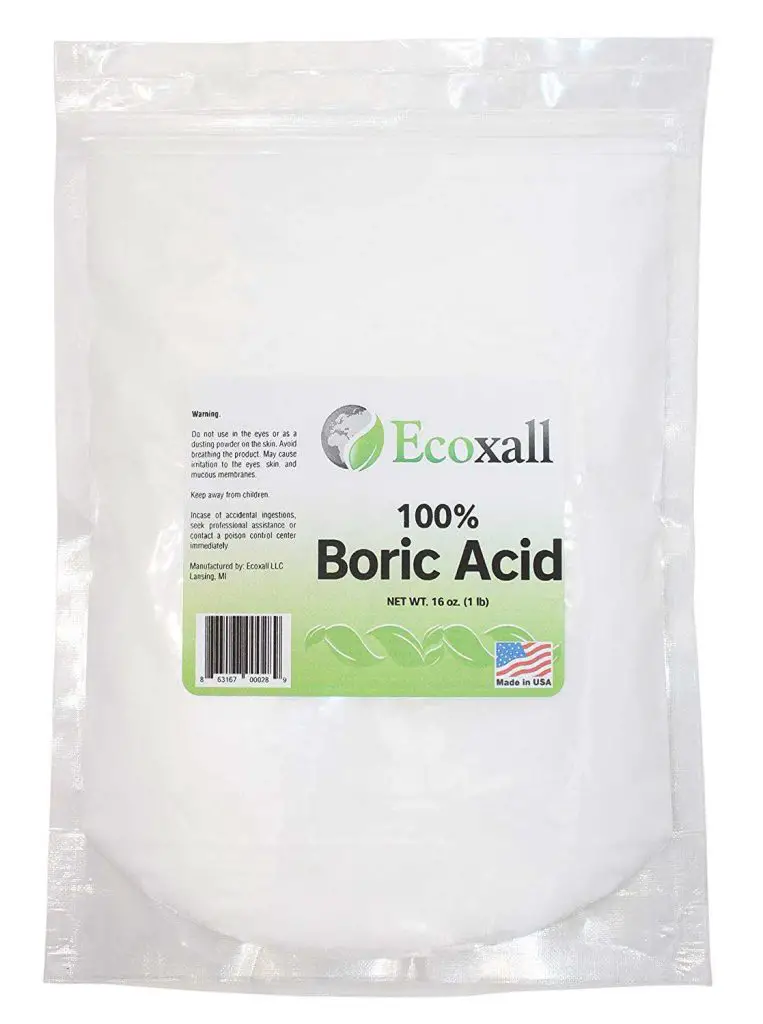
#2. Large-Scale Eradication Methods
These are the methods applied when the hammerhead population is too much or the area affected is very large. These methods are a bit complex and can be expensive as well. However, large-scale eradication methods can be very effective. Let’s discuss them in detail:
Soap Sprays: Soap sprays are extremely effective in killing all types of worms, particularly hammerhead worms. These are not too much toxic but kill the worms simply by smothering them with soap. This prevents the worms from breathing and eventually kills them. Soap sprays are easily available in garden centers and from online suppliers. You can also make it at your home by mixing one or two tablespoons of liquid soap in a small spray bottle. You can also check this insecticide soap spray on Amazon.
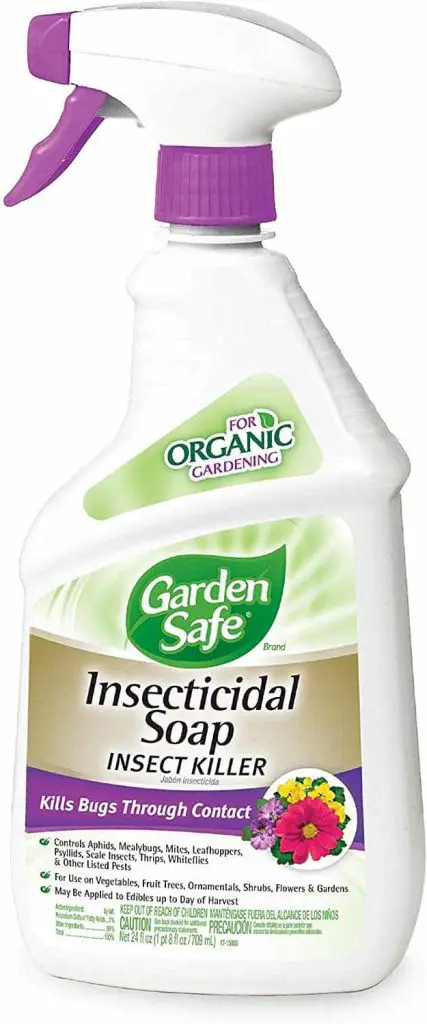
Neem Oil: Hammerhead worms are considered pests and cause great damage to earthworms. Therefore, pesticides can also be used to get rid of these tiny creatures. Neem oil is a natural pesticide and is obtained from the neem tree. It is a poisonous extract and is readily available in garden centers. It is widely used because it has little effect on other useful worms and insects. You can also check our best pick neem oil on Amazon.
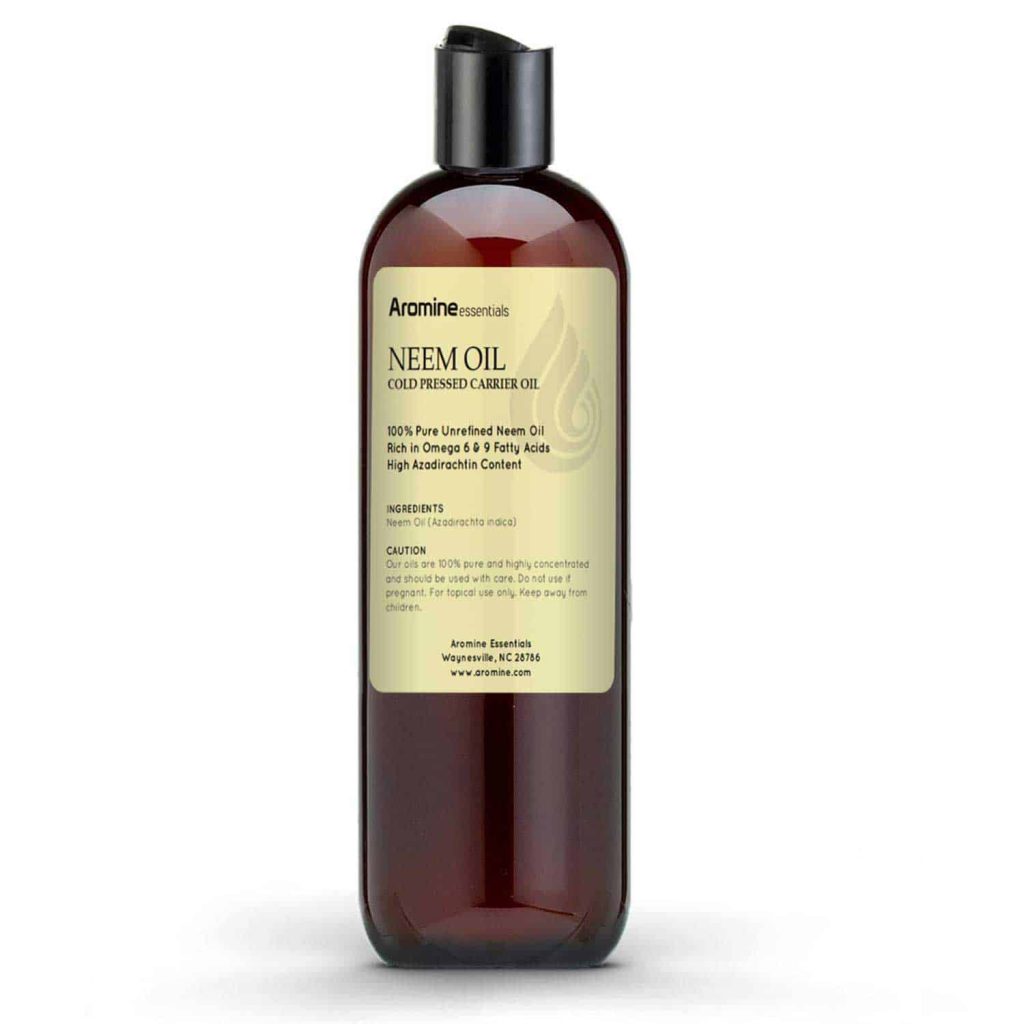
Pyrethrum: This is one of the most toxic natural pesticides and is derived from the pyrethrum daisy. It is effectively used to kill hammerhead worms and is generally sprayed. It is mildly toxic to people and degrades quickly in the environment. You can go with this pyrethrum dust spray to kill your hammerhead worms.

Organophosphates and Carbamates: Organophosphates are a large class of synthetic pesticides that targets the nervous system of hammerhead worms. They interact with the enzymes, disrupt nerve impulses, and eventually, kill the worms. However, they have a cumulative effect on the environment.
Carbamates work similarly to organophosphates but are less toxic and have a shorter duration of action.
Preferred Method
Now the question arises which technique should you follow to get rid of hammerhead worms in my garden? Whether you should use simple methods or large-scale eradication methods? Well, the answer is easy! If you have a small area and the hammerhead worms have a small population, you must follow simple methods. However, if a large area is affected by hammerhead worms, the ideal option is to follow large-scale eradication methods.
Do Hammerhead Worms Bite
No, they don’t bite or sting. They are dangerous to touch not only for humans but also for pets. They secrete toxic chemical neurotoxins to paralyze earthworms, their favorite predator. This toxin can cause skin irritation and itching when getting in contact. It’s better not to touch and eat this worm.
They are also dangerous to humans as they carry nomadic parasites. Almost all types of worms don’t bite except bristle worms. They only bite when someone tries to carry them in their hands. They can penetrate prices inside the human body.
Are Hammerhead Worms Dangerous
Although they don’t kill humans or pets directly yet they’re harmful in a few aspects. The slimy secrets on their body are toxic that can cause irritation and other skin diseases when touched. It’s unsafe to eat and touch them.
They are not good for the ecological system. They are active predators of earthworms which is essential for the fertility of the soil. Its overpopulation is responsible for the slow growth of crops and forests. The effective decomposition process caused by earthworms can affect badly hammerhead worms.
Are Hammerhead Worms Poisonous
Do many people ask whether they should eat hammerhead worms or not? They are toxic or not?
Are hammerhead worms poisonous? Yes, they release position from the skin. If someone touches it or consumes it, it can be dangerous. They secrete highly potent neurotoxins called tetrodotoxin. The same kind of toxin is found in pufferfish. Eating it can produce symptoms like the difficulty of breathing, hoarseness, nausea, and tingling around the mouth.
Only expert chefs know how to remove posing parts from pufferfish. The symptoms of eating worms with tetrodotoxin can arise within 15 to 45 minutes after eating. This poison is one of the most potent poisons found in nature.
What Do Hammerhead Worms Do to Humans
They do nothing to humans unless they touch, taste, and carry them. They cant even bite or sting. Upon touch, the toxic chemical on their skin can cause irritation. Consuming them is also harmful. If you eat them up, you are likely to suffer from nausea.
No one knows how many toxins they carry. So, it is unsafe to touch them for humans. If you found them in your yard, don’t let your kids and pet touch them without gloves.
Can You Touch Hammerhead Worms
No, it’s strictly prohibited to touch this worm. The reason is that they produce toxic chemicals from the skin to thrive from predators. This chemical is harmful to skin cells. It can cause irritation and itching when someone touches it or handle it. Be careful don’t touch them without gloves.
Are Hammerhead Worms Toxic
Yes, they can be toxic for pets and humans. They are warning dogs in yards Don’t let them eat this worm. Although they don’t bite yet they’re toxic to touch and eat. To keep themselves safe from predators they release toxic chemicals from the skin. This toxin is some form of a neurotoxin called tetrodotoxin. It makes them toxic to eat and touch not only for humans but also for pets.
What Happens If You Cut a Hammerhead Worm in Half
If you think cutting and chopping the hammerhead worm in half can kill it, you’re wrong.
What happens if you cut the hammerhead worm in half? If you cut the worm in half it will regenerate into two worms. They have the ability to grow from the cut segment. Never cut them or crush them with the shovel. It will either increase their population instead of kill them.
What Kills Hammerhead Worms
It is clear that they’re toxic and not good for the environment as well. If killing them is the only solution how can you do it? We know chopping and crushing doesn’t work, it will either regrow into two.
What kills hammerhead worms? Killing them is super easy by pouring simple ingredients on their body such as salt, vinegar, soapy water, and alcohol. It is also important to dispose of them properly away from the yard otherwise they can regrow.
Should You Kill Hammerhead Worms
You should kill this form because there is no other way to get rid of it. There are so many reasons for killing this worm. The first one is they’re toxic to eat and touch for pets and humans. The second one is they can prey on earthworms that are needed for the healthy growth of your garden. Finally, they can destroy the ecosystem if their population grows limitlessly.
Only killing will not work if you don’t dispose of them properly. Kill them by dissecting them in salty water, vinegar, soapy water, and boric powder solution. Put them in a bag with gloves and throw them away from the yard and pets.
How Do I Treat My Yard For Hammerhead Worms
The only way to treat yards with Owens is to eradicate them. There are different ways for small-scale eradication of worms and large-scale tradition. First, check the yard for its population.
How do I treat my yard for hammerhead worms? For large-scale eradication of worms use organophosphate and carbamate pesticides. For small-scale eradication of Owens, use salt, vinegar, soapy water, and alcohol. It’s better to seek the help of professional pest control authorities.
What Happens If You Touch a Hammerhead Worm
Almost all species of arrowhead worms secret epidermal mucus which is toxic. It appears slimy in texture. It helps the worms in the predation of earthworms. It also keeps the predators away from Owens.
What happens if you touch a hammerhead worm? The toxic chemical on the skin of this worm can cause irritation and itching. It can also alleviate the symptoms in allergic patients. It’s better to put on gloves before touching them.
Are Hammerhead Worms Real
Yes, they’re real. They exist physically all around the world. Since 1980 they’re invading many states of the United States. However, they require high humidity to strive well. This makes them adopt high living in tropical and subtropical regions.
They’re also found in close proximity to earthworms because they’re primary predators of earthworms. They are identified with a hammer or arrow-like outgrowth on the head.
Hammerhead Worm Where Do They Live
Although they’re native to Southasia yet brought to the US with horticulture plants. Since 1901 they are found in many states of the US, especially New Orleans. They are widely used in zoology classes for demonstration purposes.
They prefer rainy and high-moisture areas to live in. For this reason, you can find them in both tropical and subtropical regions. They are also found in Uk and are a major threat to British earthworm species.
Hammerhead Worm Dangerous To Humans
Why call them dangerous worms if they don’t bite or sting? There are many proven scientific facts to call these planaria dangerous to humans. Let’s check below:
Hammerhead worms are dangerous to humans for three reasons
They carry toxic chemicals on the skin that can cause irritation or allergies when touched.
They also carry parasitic nematodes. If they are overpopulated they can destroy the ecosystem by killing effective earthworms.
Hammerhead Worms Tetrodotoxin
Tetrodotoxin is a poisonous compound found in the ovaries of pufferfish and the skin of hammerhead worms. This high-potency toxin has the ability to block the transmission of signals from nerves to muscles causing paralysis.
Hammerhead uses this toxin to immobilize its predator earthworm. This creature quickly wraps this toxin around the body of the predator. As a result, the metabolic activities stop and predator paralysis. It makes it easy for kewnese to eat up the predator easily.
How Do You Kill Hammerhead Worms
There are many ways of killing this worm. Depending on its population, you can choose either to kill them with vinegar, salt, soapy water, or alcohol. For overpopulated killing on large scale, you may require pesticides. Remember killing with a shower will not work. They have the potency to regenerate cut fragments.
There are 5 effective ways of killing this worm:
- Killing by dissolving in salty water
- Killing by throwing alcohol on their body
- Killing by throwing them in vinegar
- Killing by putting soapy water on its skin
- Killing by using pesticide sprays.
What Eats Hammerhead Worms
So far we know that hammerhead worms kill earthworms vigorously. Now the question is: Is there any predator of hammerhead worm or not?
What eats hammerhead worms? Unfortunately, there is no well-known predator of this worm. Its foul smell keeps other animals away from it. There is only a little evidence of snakes attacking and eating this worm.
Where are Hammerhead Worms Found in the US
Since 1900, hammerhead worms have been invading the US. They were transported through shipment with horticulture plants They are mostly found in states with warm and humid weather conditions
Where are hammerhead worms found in the US? They are found in Louisiana, Florida, Mississippi, Carolina, Georgia, North Carolina, South Carolina, and Texas. They also thrive well in nurseries and greenhouses. You can find them in hot and humid places.
Hammerhead Worm in Texas
The historical data claim the presence of flatworms in Texas around 1980. However, there is no exact figure available to prove the number.
In Texas, the Invasive Species Institute reported the presence of hammerhead worms. They are found in sizes 12- inches. Some are only 15- inches long. They look like snakes. During hot and humid weather, texas dwellers can easily find this animal under rocks, trees, and near nurseries.
They are also found in other states of the US with significant humidity.
Hammerhead Worm Washington State
The arrival of the hammerhead worm in the US is recorded back in 1900. They are mostly found in states where the weather is extremely humid and sometimes hot. There is no evidence for the presence of hammerhead worms in Washington. However, they are found in neighboring states where the population of earthworms is enough. They prey and live on predating earthworms mostly.
Can Hammerhead Worms Hurt Dogs
Are hammerhead worms harmful to dogs? Yes, they’re. If a dog eats them, it can cause poisonous effects. However, the symptoms may vary with the quantity of toxin each species carry. There is no way to tell how much toxin each species carries.
Are hammerhead worms harmful to dogs? They don’t bite and sting animals. However, they are harmful to eat and touch. The toxic secretion produced from the skin of this worm is highly potent to harm animals like dogs. So monitor your pets if you see them in your yard.
Where Did Hammerhead Worms Come From
Hammerhead worms actually originated from Asia and Madagascar. Being invasive, they’re now spread worldwide. They are believed to be native to Southasia. They were transferred to the US through shipment in plants. They were transferred to Europe through horticulture. You can see them invading both tropical and sub-tropical regions all over the world.
Hammerhead Worm Hunting
Are hammerhead worms good hunters? What animals do they hunt? Do they prey on any animal other than earthworms? How do they hunt? Many such questions are covered in the answer below:
Hammerhead worms mostly hunt soft-body animals such as slugs, snails, earthworms, arthropods, sowbugs, and insects. They trap and then wrap the body of predators with a slimy toxin to immobilize them especially. After this, they eat it up easily.
How Did Hammerhead Worms Get Here
If you find them in your locality or yard, it might surprise you. You will surely think about how did they get there.
How did hammerhead worms get here? Maybe they reach your locality following earthworms their primary predator. Maybe they reached there due to improper disposal after a killing in your neighborhood. Most get to any locality through neighboring areas or garbage.
Should I Kill Hammerhead Worms: 3 Reasons
Is killing this worm the only option? Should I let them live and thrive? If they don’t damage at all why kill them? Killing them for known reasons is fair. Many people ask: Should I kill hammerhead worms?
Yes, you should kill them as it is the only solution to get rid of them completely. They are dangerous for you and your pets. You can kill them by dissolving them in salty water, vinegar, soapy water, and alcohol. Neve tries to cut or split them, they will regrow into two.
In short, there are 5 valid reasons for killing this worm:
- Toxic chemicals on its skin
- Not safe to eating
- Not good for the ecosystem
- Active predator of effectively decomposing earthworm
- Parasitic worms carry nematodes
Frequently Asked Questions
Are Hammerhead Worms Harmful?
Hammerheads are terrifying and toxic terrestrial flatworms. These are invasive species and eradicate earthworms. However, hammerhead worms don’t pose a direct threat to human beings.
How Long Are Hammerhead Worms?
These worms have muscular, colorful bodies and can grow up to 40 centimeters in length. They occupy a range of ecosystems on land.
What Type of Worm Has a Flat Head?
Most commonly, Bipalium, a genus of land planarians, has a flat-shaped head. They are also known as hammerhead worms or broadhead planarians.
What is The Best Habitat For Hammerhead Worms?
Hammerhead worms are mostly found in tropical and subtropical regions of the world. They require humidity to survive and are uncommon in deserts and mountain biomes.
How to Recognize a Hammerhead Worm?
These worms can be easily recognized by the distinctive shape of their head region. They have a “hammer-like” flathead and therefore, are known as hammerhead worms.
Conclusion
Finally, you get your ultimate solution about how to get rid of hammerhead worms. Hammerhead worms are a usual part of gardens and fields but it is important to get rid of them. Otherwise, they will finish all the earthworms in your field, making it less fertile.
But before you decide to finish these tiny creatures, you must know whether to use simple methods or large-scale methods, looking at your area. These are the predators of earthworms. However, they are not harmful to humans or other household pets.

